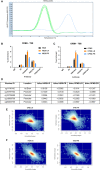Dual inhibition of DNMTs and EZH2 can overcome both intrinsic and acquired resistance of myeloma cells to IMiDs in a cereblon-independent manner
- PMID: 29130642
- PMCID: PMC5792743
- DOI: 10.1002/1878-0261.12157
Dual inhibition of DNMTs and EZH2 can overcome both intrinsic and acquired resistance of myeloma cells to IMiDs in a cereblon-independent manner
Abstract
Thalidomide and its derivatives, lenalidomide and pomalidomide (also known as IMiDs), have significantly changed the treatment landscape of multiple myeloma, and the recent discovery of cereblon (CRBN) as their direct biological target has led to a deeper understanding of their complex mechanism of action. In an effort to comprehend the precise mechanisms behind the development of IMiD resistance and examine whether it is potentially reversible, we established lenalidomide-resistant (-LR) and pomalidomide-resistant (-PR) human myeloma cell lines from two IMiD-sensitive cell lines, OPM2 and NCI-H929, by continuous culture in the presence of lenalidomide or pomalidomide for 4-6 months, until acquirement of stable resistance. By assessing genome-wide DNA methylation and chromatin accessibility in these cell lines, we found that acquired IMiD resistance is associated with an increase in genome-wide DNA methylation and an even greater reduction in chromatin accessibility. Transcriptome analysis confirmed that resistant cell lines are mainly characterized by a reduction in gene expression, identifying SMAD3 as a commonly downregulated gene in IMiD-resistant cell lines. Moreover, we show that these changes are potentially reversible, as combination of 5-azacytidine and EPZ-6438 not only restored the observed accessibility changes and the expression of SMAD3, but also resensitized the resistant cells to both lenalidomide and pomalidomide. Interestingly, the resensitization process was independent of CRBN. Our data suggest that simultaneous inhibition of DNA methyl transferases and EZH2 leads to an extensive epigenetic reprogramming which allows myeloma cells to (re)gain sensitivity to IMiDs.
Keywords: 5-azacytidine; cereblon; epigenetics; immunomodulatory drugs; multiple myeloma.
© 2017 The Authors. Published by FEBS Press and John Wiley & Sons Ltd.
Figures




References
-
- Andersen CL, Jensen JL and Ørntoft TF (2004) Normalization of real‐time quantitative reverse transcription‐PCR data: a model‐based variance estimation approach to identify genes suited for normalization, applied to bladder and colon cancer data sets. Cancer Res 64, 5245–5250. - PubMed
-
- Angers S, Li T, Yi X, MacCoss MJ, Moon RT and Zheng N (2006) Molecular architecture and assembly of the DDB1‐CUL4A ubiquitin ligase machinery. Nature 443, 590–593. - PubMed
-
- Broyl A, Kuiper R, van Duin M, van der Holt B, el Jarari L, Bertsch U, Zweegman S, Buijs A, Hose D, Lokhorst HM et al (2013) High cereblon expression is associated with better survival in patients with newly diagnosed multiple myeloma treated with thalidomide maintenance. Blood 121, 624–627. - PubMed
Publication types
MeSH terms
Substances
LinkOut - more resources
Full Text Sources
Other Literature Sources
Medical
Research Materials

